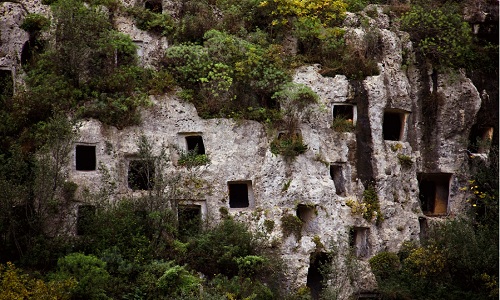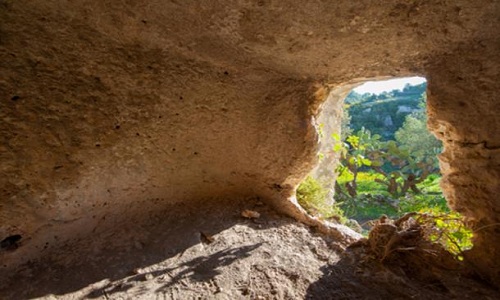The strange 'honeycomb' grave on the island of Sicily Italy
The Pantalica graveyard in Sicily, Italy is a prehistoric grave complex, consisting of thousands of graves carved into the canyon wall, resembling a honeycomb.
Cemetery of strange Pantalica stone in Italy
Between many caves and cliffs, about 5,000 tombs can be seen from afar, most of them are carved into limestone mountains. The tombs are relatively small, with square, rectangular or oval shapes. When inside, they are like artificial caves and some have lots of space.

A grave site in Pantalica graveyard.(Photo: Carlo Columba / Flickr.)
The graveyard of Pantalica lies hidden on the Hyblae Mountains, extending 1,200 m from north to south and 500 m from east to west in Sortino, Sicily. Located in the valley formed by the rivers Calcinara and Anapo , this area gathers graves along the mountainside.
Pantalica cemetery is made up of 5 graves.Filiporto with nearly 1,000 tombs is located on the southwest side of the headland. The North West tomb formed in the 11th-12th century BC. The Cavetta grave includes tombs and cliff houses that existed since prehistoric times. The North contains about 1,000 graves on steep peaks overlooking the Calcinara River while the South stretches over 1 km along the Anapo River.

Inside a tomb carved into limestone cliffs.(Photo: Siculodoc.)
Pantalica was founded by native people from coastal Sicily , developed at the end of the Bronze Age. They began to grave on the cliff in the early 12th century BC. However, the burial site was abandoned when the Sicani arrived in the 7th century BC.
In 1300 BC, the Sicani tribe entered the valley between the Anapo and Calcinara rivers. They live on rugged high mountains to defend, take advantage of natural limestone caves and dig more burrows into the mountains.
In the early Roman period, new tombs continued to be created. After many centuries, Pantalica had people living in the 8th and 9th centuries AD, acting as an important defensive base against Arab invaders. Muslims then discovered this rugged canyon as the ideal refuge and established a medieval community here.
For more than three millennia, Pantalica has become a testimony to the development of civilizations and the largest stone graveyard in Europe.
- Etna volcano on Sicily island of Italy works again
- Italy: Earthquake shook the island of Sicily, dozens of people were injured
- Beautiful photos of Italy
- New discovery of the origin of the world's oldest wine
- Sicily island volcano suddenly erupted, 10 people were injured
- Volcanic eruption created hail
- Impact of honeycomb charcoal on health
- Relocate honey bee nest 35,000 in the wall of American people
- Strange story about dolls lying in the grave crying
- The people hunted 10-storey beehive in the Nghe An-Lao border
- The biggest honeycomb in the world shows up
- Discover 9 islands with strange shapes
 'Fine laughs' - Scary and painful torture in ancient times
'Fine laughs' - Scary and painful torture in ancient times The sequence of numbers 142857 of the Egyptian pyramids is known as the strangest number in the world - Why?
The sequence of numbers 142857 of the Egyptian pyramids is known as the strangest number in the world - Why? History of the iron
History of the iron What is alum?
What is alum? Unique single world hotel located in the territory of the two countries
Unique single world hotel located in the territory of the two countries  Paternoster - The most dangerous elevator in the world
Paternoster - The most dangerous elevator in the world  5 artifacts 'fake' cause 'shake' of the world
5 artifacts 'fake' cause 'shake' of the world  10 world famous ancient ruins
10 world famous ancient ruins  13 groundbreaking scientific inventions that people borrow from nature
13 groundbreaking scientific inventions that people borrow from nature  How is the baby created?
How is the baby created? 